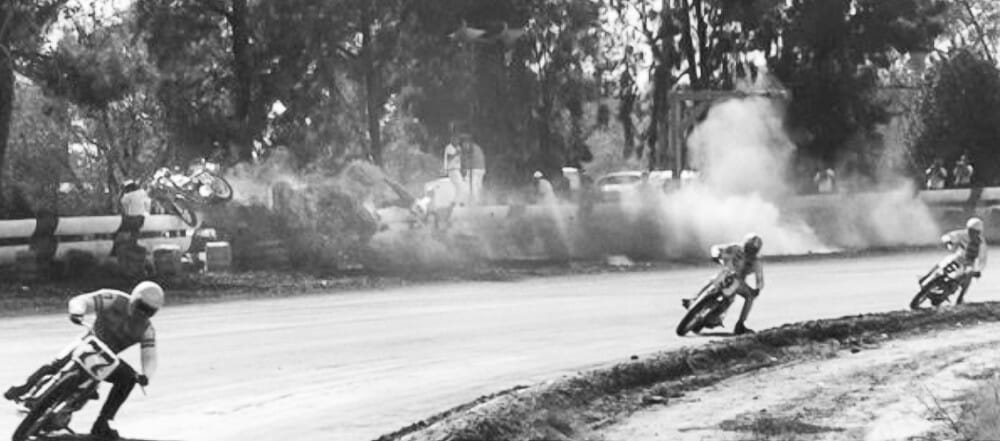Cycle News Archives
COLUMN
This Cycle News Archives edition is reprinted from issue #16, April 27, 2005. CN has hundreds of past Archives columns in our files, too many destined to be archives themselves. So, to prevent that from happening, in the future, we will be revisiting past Archives articles while still planning to keep fresh ones coming down the road -Editor.
Rice Rocket
Thanks to the blockbuster motorcycle film On Any Sunday, factory BSA rider Jim Rice’s career is synopsized by a loud, screeching, violent ribbon of film that captures his crash at the 1970 Sacramento Mile. And that just isn’t fair, because during his short ride as a professional motorcycle racer, Rice was never loud, screeching or violent.

“I was kind of a quiet guy—definitely not an [David] Aldana,” Rice, now 57, says. “Some people may have perceived me as being not a very nice person, but later on I started getting more outgoing. It was all a matter of just growing up.”
Rather than party and go wild, Rice chose to immerse himself in his equipment with the same passion as his more veteran peers, such as Mert Lawwill and Dick Mann. “I really tried to develop my skills not only as a rider but also as a mechanic,” Rice says. “I basically did 99 percent of the work on my own bikes, and I maintained them at the races, kind of like the Dick Mann program. I had some help with machining, but I built and maintained the motors and the equipment and stuff. I had a friend, Mike Akatiff, who traveled with me, and he had his own motorcycles that he would build, and I would have the choice of riding them if I wanted to. In fact, I won the Peoria TT in 1970 on his bike.”
Rice’s thoughtful, hands-on approach to racing made him somewhat of an innovator during the introduction of a new piece of safety equipment on flat track motorcycles during the 1969 season: brakes.
A year later, Rice would find himself engaged in a title battle that was a bit weirder and lasted just a tad longer than we are led to believe in On Any Sunday.
“I thought it was going to be my year,” Rice says of the ’70 season. “Having won those three Nationals in 1969, I was pretty confident about my ability to perform at that level. Actually, it would have been my year had a few things been different.”
First and foremost, says Rice, 1970 was the only season in which the AMA elected to base its points payout in proportion to what the purse paid. In other words, the larger the purse, the larger the amount of championship points that went along with it.
“Consequently, all the road races had bigger purses,” Rice says. “If you were a real good road racer, you could certainly have a big advantage. Like Daytona—if I remember correctly—to win that one race was over 100 points. The normal dirt track Nationals paid about 20 points to win, so you could win five dirt track races, which are as hard to win as any road race National—probably harder because the competition was much closer—and if someone else won one road race… That is not a good system. They [AMA] made a big mistake about doing that, and the following year they reverted back to the old system.”
So it was that Rice, who won a season-leading six Grand Nationals through the 1970 season, was locked into a title battle with Triumph’s Gene Romero, who had done better in the road races than Rice but had won just one Grand National heading into the Sacramento Mile. Also in the hunt were Rice’s BSA teammates Mann and Aldana. The fateful day, in which Rice suffered probably the most famous motorcycle crash ever put on film, is one he’d rather forget, but Rice is happy to set the record straight.
“There’s a lot behind that whole situation, and there’s a lot of rumors that I’ve heard,” Rice says. “Basically, I had the choice of riding my BSA twin or the three-cylinder of Tom Cates. It was the same three-cylinder in a Trackmaster frame that I had won the Sedalia Mile on and, believe me, that thing had a lot of straightaway speed. You could pull five or six bike lengths on each straightaway, but the problem was that at Sacramento it would hang the left case going into the turns and the wheels would skate. It was pretty challenging to ride, but it was a fun bike to ride.
“But the problem was that I went out and rode the three in practice, and it just didn’t feel quite right to me,” Rice says. “My times were really close to what I was doing on my twin. I didn’t know it at the time, but the three had either a blown or leaking head gasket on one cylinder, which dropped the power down.”
Rather than dominate his heat race, Rice was doing all he could just to guarantee a direct transfer spot to the main event on the ailing triple as he drafted Chuck Palmgren on the run to the checkered flag. All hell broke loose just after that.
“I was about an inch off Palmgren’s rear wheel to keep from getting passed by Tommy Rockwood, but right after the finish line Palmgren sat up and started slowing down, and I was so close to him, and it surprised me that he shut off,” Rice says. “I went for the rear brake, and I nicked the gearshift lever in the process and knocked it in between gears. The bike was freewheeling, and I tried jamming it back in gear, but it would not go. There was no way I could make the turn, and I remember thinking, ‘Man, I’ve got to lay this thing down quick.’ This all happened in less than two seconds.”
Rice says he blacked out before slamming into the guardrail while the triple vaulted it and struck a photographer, who was seriously injured.
“I remember coming to in the ambulance and doing a body check to make sure everything worked,” Rice says. “It did, but I was kind of freaked out because there was all this blood, and I didn’t know where it was coming from. Then I figured out that I had broken my nose.”
As the movie portrays, Rice climbed out of that ambulance and attempted to compete, but the souring BSA triple was even more battered than he was.
“By then we knew that something was going wrong with the motor, and we didn’t have time to fix any of that,” Rice says. “Of course, I wasn’t in real good shape either. I think I finished 14th.”
The movie leads viewers to believe that Romero’s win at Sacramento clinched the championship that day. In fact, it did not. There were still two races remaining, and though it would take a miracle, Rice still had a mathematical shot at retaking the points lead.
“But the next race was at Ascot, and Ascot and I never got along,” Rice says. “I didn’t like that place. I think I got fifth there, and that was a pretty good finish for me. Romero won it, but like I say, if the points system had been the same as the year before or the year after, I would have probably had a 300-point lead on him.”
But don’t think now that Rice is complaining about not winning the championship. Instead, he relishes the time he spent as a professional motorcycle racer, a career that lasted through the 1974 season before Rice elected to walk away while he still could walk away.
“Motorcycle racing was the soul of my existence back then,” Rice says. “I’m happy to have raced when I did because I think that is unquestionably the golden era of dirt track racing in terms of spectator attendance, brand loyalty and brands that were supported by the various factories. You had Kawasakis racing Nortons and Yamahas and Hondas, BSAs and Triumphs. It was also the time when there was the highest level of competition. At San Jose, you’d have 140 guys trying to get 40 qualifying spots. Nowadays, you don’t have 40 guys show up to the race.”
Today, Rice lives in Portola Valley, California, with his wife, Lisa, and 12-year-old son, Kyle. Rice owns his own electronic manufacturing and design business. CN
Click here to read Archives Column in the Cycle News Digital Edition Magazine.
Click here for all the latest Flat Track racing news.
Subscribe to nearly 50 years of Cycle News Archive issues
